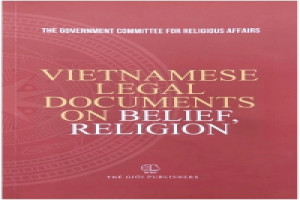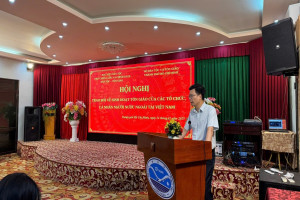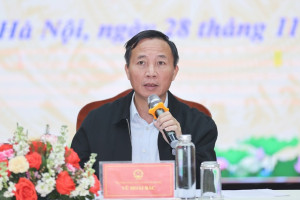
Born from a spiritual vision, Caodaism has grown into a global symbol of Vietnamese culture and faith.
Over a century of growth from the southern provinces of Vietnam to the world stage, Caodaism has stood not only as a faith rich in spiritual mythology, but as an indigenous religion devoted to preserving and promoting Vietnamese cultural identity in an era of global integration.
A profound vision of unity and compassion
Caodaism, officially known as the Great Way of the Third Universal Redemption (Dai Dao Tam Ky Pho Do), is one of 16 religions formally recognized by the Vietnamese government.
Founded in Southern Vietnam in the early 20th century, the birth of Caodaism is deeply linked to legendary spiritual encounters. Prof. Thượng Mai Thanh Chairman of the Caodai Holy See in Hanoi, shared a revered tale of Ngô Văn Chiêu (pen name: Ngô Minh Chiêu), the first disciple of Caodaism:
"In the 10th lunar month of the Year of the Monkey (1920), Ngô Văn Chiêu was appointed to Phu Quoc Island. One early morning during meditation, while contemplating the ways of worshipping celestial beings, he witnessed a radiant, glowing image of a massive Eye of Heaven (Thien Nhan) appear before him. Days later, it reappeared. Through spiritual communication, the divine being Cao Dai Tien Ong Dai Bo Tat Ma Ha Tat instructed him to depict and venerate this sacred symbol."
Though some early opinions suggested Caodaism was created by colonial-era officials, Professor Mai refutes this. Among the first 12 disciples spreading the faith across Southern Vietnam were local leaders such as Phạm Công Tắc, Lê Văn Trung, Vương Quan Kỳ, Cao Quỳnh Cư and Cao Hoài Sang, etc. Many held government positions, helping to rapidly grow a devoted following.
Caodaism's core teachings were communicated to the original disciples through spirit writing (cau co). After a year, these messages were compiled into the Holy Words Collection (Thanh Ngon Hiep Tuyen), one of the two foundational texts of the religion, alongside Phap Chanh Truyen, which governs organizational structure and doctrine.
Caodaism does not recognize social hierarchy. Even high-ranking clergy refer to each other and to followers simply as "brother" or "sister." Rituals are simple, with daily offerings consisting of flowers, wine, water, and tea.
On the 15th day of the 10th lunar month in 1926, the inauguration of Caodaism took place in Tay Ninh province, marking the religion’s formal birth. Its mission: Unifying the three teachings and five paths - where the three teachings include Buddhism, Taoism, and Confucianism; and the five paths consist of humanism, shamanism, sainthood, immortality, and Buddhism.
“Caodaism is rooted in love and unity. All religions, whether Buddhism, Catholicism, or Islam, share the same divine origin and are part of one universal family. Thus, followers must embrace one another,” Professor Mai emphasized.
Within just three months of its founding, millions of people had joined the Cao Dai faith.
Tay Ninh Holy See: A sacred architectural marvel with no blueprint

The Tay Ninh Holy See was constructed entirely without architectural plans or blueprints. Photo: Long Hoa Ward Official Portal
One of the most extraordinary stories in Caodaism history is the construction of the Tay Ninh Holy See.
In its early days, Caodaism did not have a dedicated place of worship. The abbot of Tu Lam Pagoda (also known as Go Ken Pagoda) lent his temple in Tay Ninh for the founding ceremony. Shortly thereafter, he reclaimed the property.
Following divine instructions, the disciples purchased 96 acres of wilderness in Tay Ninh from a French forest officer, thanks to funding from Lâm Hương Thanh and Thái Thọ Thanh. They cleared the land - then teeming with tigers and leopards - to build the Holy See during a time (1926-1927) when Vietnam remained impoverished and undeveloped.
Historical accounts state that Phạm Công Tắc, one of the first disciples and chief overseer of the project, meditated nightly to receive divine guidance. Construction followed a step-by-step spiritual process, employing 500 single men and 500 single women.
"The Tay Ninh Holy See was built without a single drawing or architect. It was the result of unshakable faith, crafted entirely by Vietnamese hands and minds. The 28 dragon pillars, made from bundled tam vong bamboo, have withstood a century of trials," Mai noted.
Serving both faith and nation

Upholding the principle of “good religious and secular life” Hanoi’s Caodai Holy See carries out various charitable and social welfare activities. Photo: Correction -Path Caodai Church
Guided by the motto "Glory to the nation, enlightenment to the faith," Caodai has not only been a spiritual foundation but has also played a significant role in Vietnam’s national development and defense.
The Correction – Path (Ban Chinh dao) Caodai Church, founded by Pope Nguyễn Ngọc Tương in 1936, made notable contributions during the resistance against French colonial rule and was awarded the Second-Class Resistance Order.
Many Caodai followers joined the revolutionary ranks, including leadership in the Southern Party Committee. The religion also supported the revolution by donating resources, including an entire printing press.
Remarkably, Pope Nguyễn Ngọc Tương urged temples to accept young men into religious life to help them avoid conscription and bloodshed - a profound act of peaceful resistance.
Among the most prominent figures of the faith is Cao Triều Phát, leader of Caodaism in Hau Giang province. He donated thousands of hectares of land and property to the revolution, joined the Viet Minh Front, and led battles such as the one at Ngoc Minh Holy See (That Giong Bom). He later became a member of Vietnam’s first National Assembly.
His iconic statement - "There may be many altars for religion, but there is only one altar for the Fatherland" - remains a timeless affirmation of Cao Dai’s patriotic spirit.
Today, Caodai dignitaries and followers continue this tradition by engaging in volunteerism and community development.
Recently, Prof. Thượng Mai Thanh was awarded a commemorative medal by the Hanoi People's Committee for contributions to public security. Many Cao Dai communities help maintain local safety and have become model groups for environmental protection and climate action.
“Our Hanoi congregation, part of the Correction - Path Caodai Church, includes more than 100 members, about 30 of whom actively participate in charity work. Our humanitarian fund amounts to several million VND each year (roughly 200–300 USD), made up of personal savings by followers. We live by Prime Minister Pham Minh Chinh’s words: ‘Those who have more give more; those who have less give what they can,’” Mai shared.
“Every lunar month, on the first day, we offer around 300–400 free bowls of vegetarian bun rieu to those in need at our center on 48 Hoa Ma Street. With more support, we hope to expand these efforts.”
Spreading Vietnamese culture to the world

Prof. Thượng Mai Thanh introduces Minister of Ethnic and Religious Affairs Đào Ngọc Dung to Caodaism’s historic contributions over the past 80 years. Photo: Le Anh Dung
As an indigenous faith, Caodaism also serves as a cultural ambassador for Vietnam’s global integration journey.
Unlike imported religions, Caodaism embodies Vietnamese traditions, from ceremonial attire like ao dai and khan xep to the use of the Vietnamese romanized script (quoc ngu) in scriptures and poetic forms such as luc bat and song that luc bat.
Today, Caodai followers can be found across the globe, in countries including the United States, Japan, France, Australia, Canada, and South Korea.
This global presence reflects not only the faith’s resilience but also the pride of the Vietnamese people in preserving their cultural and spiritual heritage.
Caodaism now has more than 1.1 million followers, around 10,000 clergy, 30,000 officers, 3 training schools, and over 1,300 places of worship nationwide.
The religion comprises 10 state-recognized churches, one monastic sect, and several independent establishments.
Source: vietnamnet.vn




